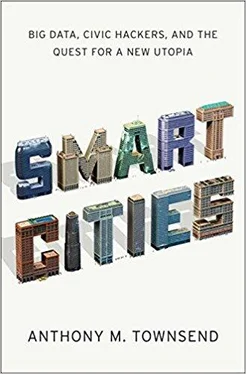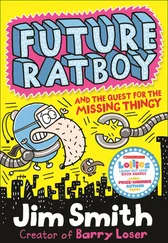But with size comes stagnation. Finding growth opportunities has become a constant struggle for Cisco, and to make a dent on the bottom line it needs to have billion-dollar payouts. The company’s ambition to become the new plumber of smart cities isn’t limited to Songdo, or even all of the to-be-built pop-up cities of Asia. The firm wants to control the nervous system of the entire urban world.
Injecting smart features into existing cities is a daunting prospect. Just making a single building smart is a monumental task of interconnection and translation. They are riddled with special-purpose networks built out in recent decades that can’t talk to each other. A single building might have one set of control wires for elevators, another for heating and ventilation, another for security, and yet another for lighting. Integrating a whole city full of these legacy networks presents an almost intractable problem.
To Cisco, however, the problems that hamper would-be smart cities look a lot like the ones that universities and corporations faced in the early days of the Internet. The challenge then was connecting hundreds or thousands of independent local area computer networks (LANs) into an integrated Internet. The challenge now is figuring out how to interconnect fragmented city infrastructure by using the Internet to bridge these gaps in the urban fabric. Soon after signing up as Songdo’s chief technology supplier, Cisco spun up a smart city engineering group at its new “second headquarters,” the Globalisation Centre East in Bangalore, India.60 “Today, urban centers struggle with hundreds of different systems and protocols that do not interoperate,” a brochure touting the new lab proclaimed. “If these systems converge onto a single open-systems based network, significant opportunities for productivity, growth, and innovation can be unleashed.”61 It was a compelling if somewhat quixotic vision of progress for a fast-changing urban world.
As a corporate strategy, it seemed like a slam dunk. Ciscos network would unscramble the Tower of Babel that is our urban infrastructure. The company would extend its long-held dominance as the Internets traffic cop to the networks that connect buildings, vehicles, and urban infrastructure to city-scale control systems. Interconnection would enable new city-scale applications and drive growth in data traffic. And every extra bit traversing a neighborhood was another bit for Ciscos high-profit-margin routers and switches to direct. The fourth utility, deployed to interconnect the physical world, promised to be at least as big an opportunity as the original Internet, which was built to interconnect virtual worlds.
But just as the market for smart city networks was shaping up, video flooded onto the Web via fiber-optic networks laid during the telecom boom of the 2000s. Integration and automation of building and infrastructure systems might provide steady business for decades to come, but the rise of video communications held out the possibility of a wild, bucking bull that Cisco could ride to astronomical heights of profitability. Since the earliest days of television, the videophone had been one of those inventions that was perennially just around the corner. Decade after decade, prototype after prototype had failed to capture the public imagination. Finally, it seemed, the world was ready for faces to accompany voices coming over a wire.
Almost overnight Ciscos entire smart-city pitch shifted to video. In 2011 it released a “Visual Networking Index” that highlighted the coming crush. By “2015, the gigabyte equivalent of all movies ever made will cross global IP networks every 5 minutes,” the company predicted. But instead of quenching the fire, Cisco was throwing on fuel. Its multiscreen, high-definition TelePresence videoconferencing systems were selling very well, for hundreds of thousands dollars per unit. Beginning in 2006, it began to experiment on itself to build a business case for the technology, deploying over 250 units in 123 cities worldwide. In 2008 the company announced it had saved $90 million by eliminating travel for nearly 17,500 face-to-face meetings.63 In 2010, it acquired Norway-based Tandberg, a manufacturer of desktop videophones, and cut a deal to install the units in apartments throughout Songdo’s residential quarter.
Just as it was ramping up production of TelePresence, Cisco was putting its own spin on Songdos significance for a rapidly urbanizing China.
“Or course I can see you! You’re as big as a wall!” exclaims a venerable Chinese gentleman. In a luminous, light-filled apartment in the Shanghai of 2020, we snoop on a joyous video call between an elderly couple and their friend, discussing the upcoming evening’s reunion for a wedding anniversary celebration. A cinema-sized display occupies the entire wall of their living room.
Shanghai’s Expo 2010 was arguably the most important international showcase since the 1939 World’s Fair in New York. And much like that earlier exposition, a phalanx of corporations looking to cash in on the next building boom promulgated visions of how to shape the landscape of a newly prosperous nation. The theme was, simply “Better City, Better Life.” In 1939, General Motors’ exhibit envisioned how one technology, the automobile, could power a future migration of Americans out of cities into the suburbs. But in Shanghai, Cisco’s pavilion demonstrated how a very different technology, high-definition videoconferencing, could restore harmony to a China fractured by a massive migration from the countryside into cities that was just reaching its climax. The million-plus families displaced in the reconstruction of Shanghai as a modern, global city would be stitched back together by the Internet.
The heart of Cisco’s show was a seven-minute video depicting a day in the life of 2020 Shanghai.63 Even before we meet the elated senior citizens, the film opens in the city’s control center, where a fast-approaching typhoon has just been detected by an advanced weather-tracking computer. As capable government managers calmly order emergency preparations, the story abruptly cuts to domestic life. We see the lives of two young couples unfold on the screen. One is on the verge of a breakup, the other about to have a baby. High-definition video communications propel the events. As her first contractions begin, the expectant mother consults her doctor from the kitchen counter, then summons her husband in his car halfway across the city. Intuitive, mobile, and effortless, high-definition video keeps the city’s residents in near-lifelike contact at a distance and on the go.
Cisco’s vision painted the aspirations and fears of modern China with coarse strokes. It promised to recapture all that had been lost in the country’s rapid urbanization, which in two decades had transformed the Chinese family more fundamentally than the two millennia that preceded them. Traditionally, Chinese lived in multigener- ational households, with many members of extended families under one roof. But the move to cities brought a shift toward more Western-style nuclear households of just parents and children. In Cisco’s future Shanghai, orphaned elders would become the early adopters of video chat.
As the typhoon closes in, the characters move through an increasingly threat-filled city. But as in a Greek myth, the heroes in Cisco’s vision of Shanghai in 2020 do not act entirely of their own free will. Like the gods of Mount Olympus, city managers peer into a miniature holographic simulacrum of the city and its inhabitants. Instead of atmospheric clouds, their aerie rests in a computational cloud. Their omniscience comes not from divinity but from a massive grid of sensors that can seemingly track anything—rainfall, traffic jams, even the movement of individual citizens. By remote control of infrastructure and instantaneous dispatch of responders, they possess an omnipotence that no mayor has ever known. Above all, order is maintained in this patently paternalistic view of the future. Shanghai’s residents of 2020 have surrendered to the guardians behind the screens.
Читать дальше












